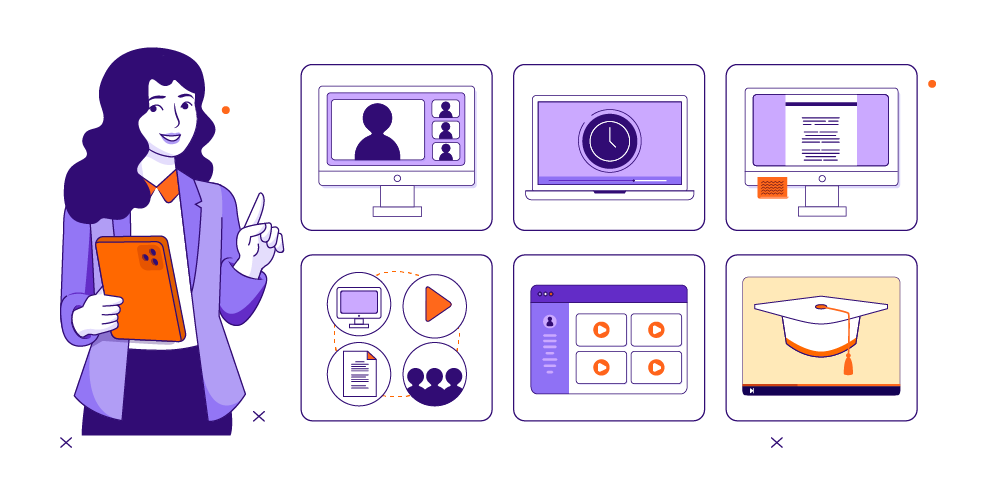
What is Blended Learning?
(Everything You Need to Know)
In today’s society, our learning environments have evolved past face-to-face training models and instructor-led classrooms. Students and working professionals can now move out of the traditional classroom (at least for some of their training ) and into a learning model known as blended learning.
But what is blended learning exactly? And how can we use it to our advantage?
Well, we will answer these questions and more in this post!
Ready to dive in?
Let’s go!
What is Blended Learning?
To understand the benefits of blended learning, we first need to define what it is.
Simply put:
Blended learning is a combination of online and in-person training methods.
If your university or corporate training program is using instructor-led classroom environments with mobile technology such as online learning platforms that allow for virtual quizzes or interactive video, for example, you are making use of blended learning.
Blended Learning vs. Hybrid Learning
If blended learning combines professional training and higher education with online learning materials, then what’s the difference between blended learning methods and hybrid learning?
It’s a valid question.
Here’s the main difference:
A hybrid learning management system is designed to be equal parts online learning and offline instruction whereas blended learning takes a virtual (or mobile) learning approach to complement its instructor-led training in the classroom or corporate environment.

Blended Learning Benefits
Why should an organization take their traditional learning experiences and move them to a blended learning model?
Well, there are many benefits that are associated with digital learning. By combining classroom instruction and in-person training with online education and technology you can take advantage of the following:
- Adapt to different learning styles. Everyone has a primary learning style and no two students learn in the same way. Moving to a blended learning environment allows you to tap into visual, auditory, kinesthetic, and written learning elements that are inclusive of everyone. This is especially true if you’re incorporating interactive video in your online course or training platform.
- Improve engagement and retention. Learning management systems that blend class time with online training give learners access to some major rewards. Among them are improved engagement and increased learner retention. In fact, 73% of teachers say that blended learning increases retention, and 82% of students prefer it to traditional teaching environments.
- Go at the Pace of the Students. The fact of the matter is that some students learn at a faster pace while other learners need time to digest information. Online training allows students to go at their own pace and learn when they have the time and energy to focus.
- Growth & Scalability. Implementing technology and the internet into your courses not only allows for a fully robust learning experience but also gives you the methods and strategies that help facilitate growth and scalability. Having these systems in place makes them easily duplicatable.

Blended Learning Models (6 Different Types)
Okay, so now you know what blended learning is and how it can benefit your organization. Now let’s discuss some options for making the switch. Here are six types of blended learning models that you can put to use.
1. Face-to-Face
The face-to-face model of instruction is the most similar to a classroom environment. The key difference is that it’s being facilitated through the use of technology like Zoom or some other form of digital meeting software tool.
Learners receive their instruction via this technology and their assignments are delivered this way as well. This allows for plenty of roleplay, feedback, and facilitation from educators.
2. Flex Model
The Flex learning model allows the learner to accommodate themselves for how they learn best. With flex learning, a student can jump between group learning, online technology and courses, and facetime with the instructor. This allows them to make use of their time how they see fit to improve their skills with instructor resources.
3. Flipped Classroom
The flipped classroom model has been around for some time now. The only difference between this and a live classroom environment is that the work is conducted ahead of time instead of being assigned during or after class.
This is similar to the face-to-face model where technology is still being used to facilitate instruction, only when the work will be assigned is flipped.
This allows students to consume lectures, courses, online content, and other external resources to maximize preparation prior to educators stepping in.
4. Rotation Model
This type of blended learning allows students or learners to rotate through a set number of fixed stations that give them the opportunity to cycle the different learning elements. For example, group training, tutoring, labs, etc. The schedule is set either by a trainer/instructor or self-imposed by the trainee.
The rotation model must make use of at least one digital learning modality that includes online technologies as part of the learning experience.
5. Enriched Virtual Model
The enriched virtual model requires learners to attend classes, either in person or online, and enrich their learning through the use of webinars, lectures, and other virtual resources.
The benefit of this for the students or trainees is that how much face-time they have with the instructor and how much virtual training they attend is at their discretion. They essentially are in control of their schedule and educational practices.
6. Online Driver Model
The online driver model of blended learning gives the students the maximum amount of autonomy compared with other learning methods. This is primarily due to the fact that the learner is solely responsible for his or her educational journey.
This also benefits universities, associations, and/or corporations by delivering a training platform that requires less time and energy from an instructor and put the ownership in the hands of the motivated self-starter who is eager to learn.
And aren’t those the type of talented people you want to attract to your organization?

Blended Learning in Education
If you are an educator that is looking for the best eLearning practices for your university and teachers, looking to the blended learning model may provide immense benefits for you.
Aside from streamlining production, increasing engagement, and having learners retain more information, it can help with the growth of educational programs as well.
Whether that be a staple in the academic world or a new and emerging field, working with a professional to build your eLearning programs may be a logical next step.
Blended Learning in Corporate Training
How does blended learning benefit a corporation or brand?
Well, for one you gain greater control over your learning environment by giving flexibility, control, and autonomy over to the learner. That’s imperative in today’s busy and digitally-immersed world.
It allows you to provide value to those who are leveling up their skills and improving their knowledge to serve your company better.
It also allows you to increase ROI and lower costs associated with full-fledged in-person learning models while gaining the advantage that comes with increased retention and engagement.
Blended Learning Examples
Let’s see how this translates in the real world by taking a look at a few blended learning examples:
- Uber/Lyft. Rideshare companies like Uber and Lyft use a blended learning model as part of their hiring process. For example, Lyft requires you to meet with a trainer in person through the app after you’ve completed training via their digital learning environment prior to becoming an independent contractor.
- Ticketmaster. Ticketmaster has incorporated a self-learning element into their customer service. They did this after an analysis uncovered that their customer service department was lacking. The answer? Product knowledge training through the use of video learning.
- Boston University. The Center for Teaching & Learning (CTL) at Boston University has fully embraced the concept of blended learning in recent years. They’re currently publishing online guides to teach their instructors how to enhance their in-class interactions. They even have a grant program that rewards such strategies.
How to Get Started with Blended Learning
Getting started with blended learning all starts with a decision. If you’d like to benefit from educational enhancement for your organization, you must start by taking the first action step.
First, you’ll need to decide on your learning objectives for your program. You may already have this nailed down from your instructor-led programs, but what advantage are you providing with blended learning? Is your goal to increase the knowledge of your employees? Is it to provide added value and autonomy to your students?
Next, you’ll need to select the right learning model and choose the right eLearning tools to build out your digital environment.
Then, it’s just a matter of proper implementation, launching your blended learning in your organization, and giving access to learners.
Need help with your launch? Contact Ninja Tropic today and we’ll provide you with a free consultation and sample plan to bring your vision to life.
Final Thoughts on Blended Learning
So there you have it:
Every you need to know about blended learning all in one convenient place. Looking for more of the latest and greatest on eLearning and video animation? Be sure to check out the Ninja Tropic Blog.
